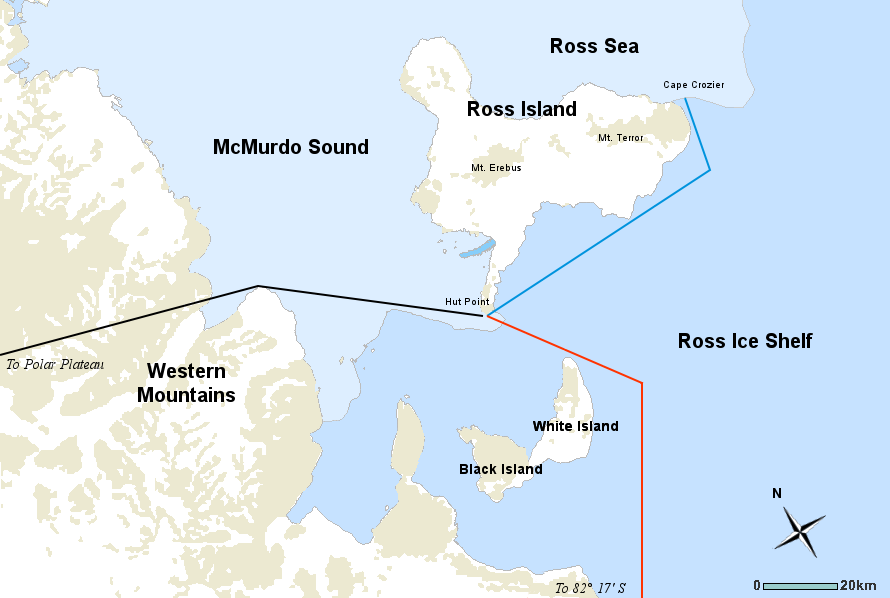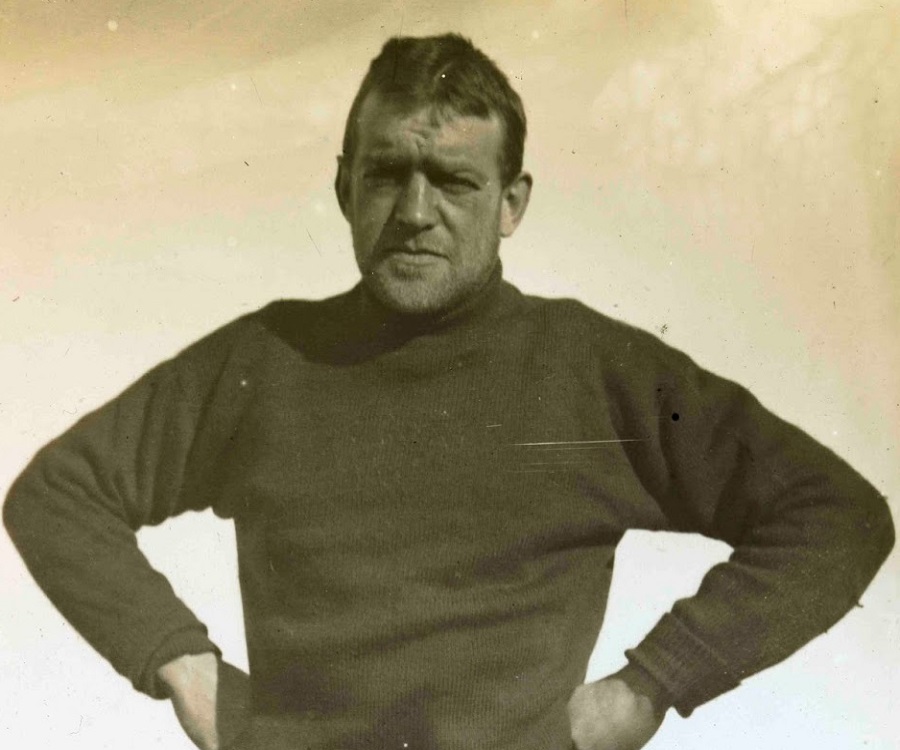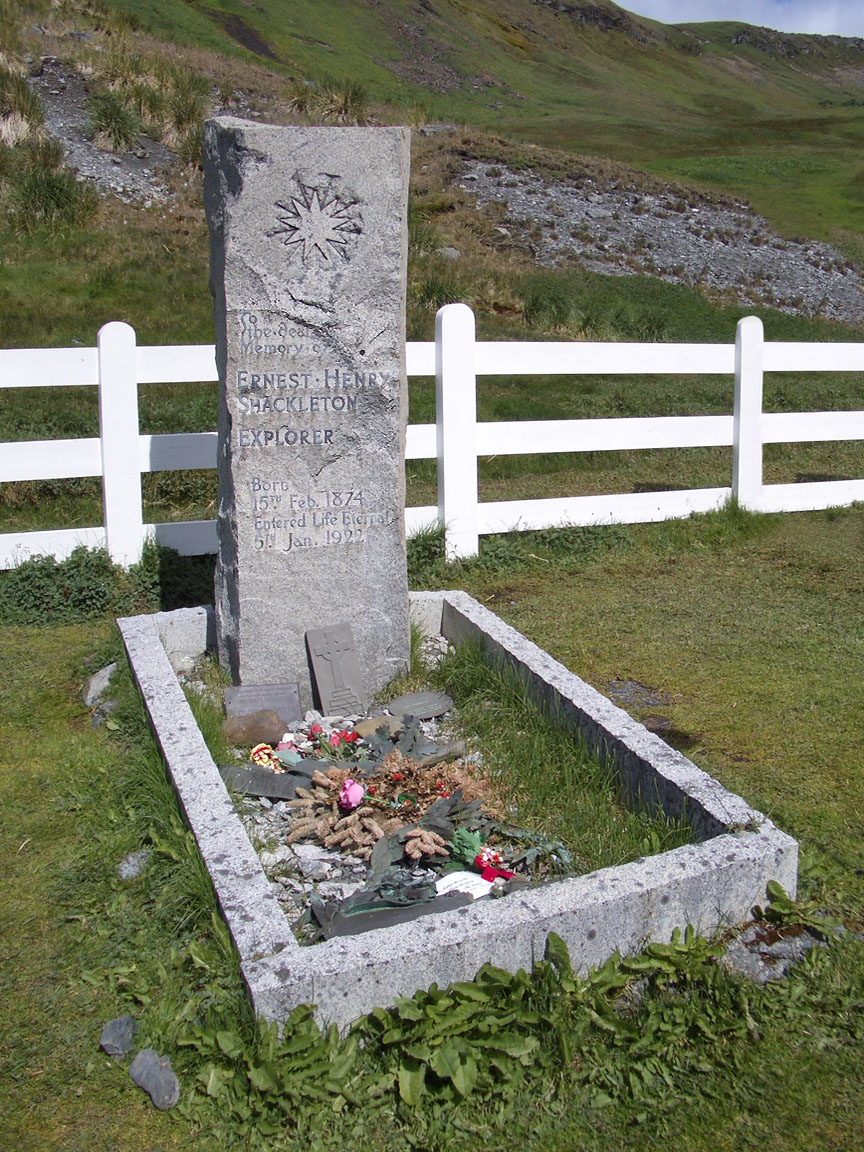Ernest Shackleton
Sir Ernest Henry Shackleton CVO OBE FRGS (15 February 1874 – 5 January 1922) was a polar explorer who led three British expeditions to the Antarctic, and one of the principal figures of the period known as the Heroic Age of Antarctic Exploration. Born in Kilkea, Athy, County Kildare, Ireland, Shackleton and his Anglo-Irish family moved to Sydenham in suburban south London when he was ten. His first experience of the polar regions was as third officer on Captain Robert Falcon Scott's Discovery Expedition 1901–1904, from which he was sent home early on health grounds, after he and his companions Scott and Edward Adrian Wilson set a new southern record by marching to latitude 82°S.
During the second expedition 1907–1909 he and three companions established a new record Farthest South latitude at 88°S, only 97 geographical miles (112 statute miles, 180 km) from the South Pole, the largest advance to the pole in exploration history. Also, members of his team climbed Mount Erebus, the most active Antarctic volcano. For these achievements, Shackleton was knighted by King Edward VII on his return home.
After the race to the South Pole ended in December 1911 with Roald Amundsen's conquest, Shackleton turned his attention to the crossing of Antarctica from sea to sea, via the pole. To this end he made preparations for what became the Imperial Trans-Antarctic Expedition, 1914–17. Disaster struck this expedition when its ship, Endurance, became trapped in pack ice and was slowly crushed before the shore parties could be landed. The crew escaped by camping on the sea ice until it disintegrated, then by launching the lifeboats to reach Elephant Island and ultimately the inhabited island of South Georgia, a stormy ocean voyage of 720 nautical miles and Shackleton's most famous exploit. In 1921, he returned to the Antarctic with the Shackleton–Rowett Expedition, but died of a heart attack while his ship was moored in South Georgia. At his wife's request he was buried there.
Away from his expeditions, Shackleton's life was generally restless and unfulfilled. In his search for rapid pathways to wealth and security, he launched business ventures which failed to prosper, and he died heavily in debt. Upon his death, he was lauded in the press, but was thereafter largely forgotten, while the heroic reputation of his rival Scott was sustained for many decades. Later in the 20th century, Shackleton was "rediscovered", and rapidly became a role model for leadership as one who, in extreme circumstances, kept his team together in a survival story described by cultural historian Stephanie Barczewski as "incredible".
In his 1956 address to the British Association, Sir Raymond Priestley, one of his contemporaries, said: "Scott for scientific method, Amundsen for speed and efficiency, but when disaster strikes and all hope is gone, get down on your knees and pray for Shackleton", paraphrasing what Apsley Cherry-Garrard had written in a preface to The Worst Journey in the World.
Discovery Expedition
The National Antarctic Expedition, known as the Discovery Expedition after the ship Discovery, was the brainchild of Sir Clements Markham, president of the Royal Geographical Society, and had been many years in preparation. It was led by Robert Falcon Scott, a Royal Navy torpedo lieutenant lately promoted Commander, and had objectives that included scientific and geographical discovery.
Although Discovery was not a Royal Navy unit, Scott required the crew, officers and scientific staff to submit to the conditions of the Naval Discipline Act, and the ship and expedition were run on Royal Navy lines. Shackleton accepted this, even though his own background and instincts favoured a different, more informal style of leadership. Shackleton's particular duties were listed as: "In charge of seawater analysis. Ward-room caterer. In charge of holds, stores and provisions […] He also arranges the entertainments."
Discovery departed London on 31 July 1901, arriving at the Antarctic coast, via Cape Town and New Zealand, on 8 January 1902. After landing, Shackleton took part in an experimental balloon flight on 4 February. He also participated, with the scientists Edward Wilson and Hartley Ferrar, in the first sledging trip from the expedition's winter quarters in McMurdo Sound, a journey which established a safe route on to the Great Ice Barrier. During the Antarctic winter of 1902, in the confines of the iced-in Discovery, Shackleton edited the expedition's magazine The South Polar Times.
According to steward Clarence Hare, he was "the most popular of the officers among the crew, being a good mixer", though claims that this represented an unofficial rival leadership to Scott's are unsupported. Scott chose Shackleton to accompany Wilson and himself on the expedition's southern journey, a march southwards to achieve the highest possible latitude in the direction of the South Pole. This march was not a serious attempt on the Pole, although the attainment of a high latitude was of great importance to Scott, and the inclusion of Shackleton indicated a high degree of personal trust.

The party set out on 2 November 1902. The march was, Scott wrote later, "a combination of success and failure". A record Farthest South latitude of 82° 17' was reached, beating the previous record established in 1900 by Carsten Borchgrevink. The journey was marred by the poor performance of the dogs, whose food had become tainted, and who rapidly fell sick. All 22 dogs died during the march. The three men all suffered at times from snow blindness, frostbite and, ultimately, scurvy. On the return journey, Shackleton had by his own admission "broken down" and could no longer carry out his share of the work.
He later denied Scott's claim in The Voyage of the Discovery, that he had been carried on the sledge. He was in a seriously weakened condition; Wilson's diary entry for 14 January reads: "Shackleton has been anything but up to the mark, and today he is decidedly worse, very short winded and coughing constantly, with more serious symptoms that need not be detailed here but which are of no small consequence one hundred and sixty miles from the ship".
On 4 February 1903, the party finally reached the ship. After a medical examination (which proved inconclusive), Scott decided to send Shackleton home on the relief ship Morning, which had arrived in McMurdo Sound in January 1903. Scott wrote: "He ought not to risk further hardship in his present state of health." There is conjecture that Scott's motives for removing him was resentment of Shackleton's popularity, and that ill-health was used as an excuse to get rid of him.
Years after the death of Scott, Wilson and Shackleton, Albert Armitage, the expedition's second-in-command, claimed that there had been a falling-out on the southern journey, and that Scott had told the ship's doctor that "if he does not go back sick he will go back in disgrace." There is no corroboration of Armitage's story. Shackleton and Scott stayed on friendly terms, at least until the publication of Scott's account of the southern journey in The Voyage of the Discovery. Although in public they remained mutually respectful and cordial, according to biographer Roland Huntford, Shackleton's attitude to Scott turned to "smouldering scorn and dislike"; salvage of wounded pride required "a return to the Antarctic and an attempt to outdo Scott."
Nimrod Expedition
On 1 January 1908, Nimrod sailed for the Antarctic from Lyttelton Harbour, New Zealand. Shackleton's original plans had envisaged using the old Discovery base in McMurdo Sound to launch his attempts on the South Pole and South Magnetic Pole. Before leaving England, he had been pressured to give an undertaking to Scott that he would not base himself in the McMurdo area, which Scott was claiming as his own field of work. Shackleton reluctantly agreed to look for winter quarters at either the Barrier Inlet (which Discovery had briefly visited in 1902) or King Edward VII Land.
To conserve coal, the ship was towed 1,650 miles (2,655 km) by the steamer Koonya to the Antarctic ice, after Shackleton had persuaded the New Zealand government and the Union Steamship Company to share the cost. In accordance with Shackleton's promise to Scott, the ship headed for the eastern sector of the Great Ice Barrier, arriving there on 21 January 1908. They found that the Barrier Inlet had expanded to form a large bay, in which were hundreds of whales, which led to the immediate christening of the area as the Bay of Whales. It was noted that ice conditions were unstable, precluding the establishment of a safe base there. An extended search for an anchorage at King Edward VII Land proved equally fruitless, so Shackleton was forced to break his undertaking to Scott and set sail for McMurdo Sound, a decision which, according to second officer Arthur Harbord, was "dictated by common sense" in view of the difficulties of ice pressure, coal shortage and the lack of any nearer known base.
Nimrod arrived at McMurdo Sound on 29 January, but was stopped by ice 16 miles (26 km) north of Discovery's old base at Hut Point. After considerable weather delays, Shackleton's base was eventually established at Cape Royds, about 24 miles (39 km) north of Hut Point. The party was in high spirits, despite the difficult conditions; Shackleton's ability to communicate with each man kept the party happy and focused.
The "Great Southern Journey", as Frank Wild called it, began on 29 October 1908. On 9 January 1909, Shackleton and three companions (Wild, Eric Marshall and Jameson Adams) reached a new Farthest South latitude of 88° 23' S, a point only 112 miles (180 km) from the Pole. En route the South Pole party discovered the Beardmore Glacier (named after Shackleton's patron) and became the first persons to see and travel on the South Polar Plateau. Their return journey to McMurdo Sound was a race against starvation, on half-rations for much of the way. At one point, Shackleton gave his one biscuit allotted for the day to the ailing Frank Wild, who wrote in his diary: "All the money that was ever minted would not have bought that biscuit and the remembrance of that sacrifice will never leave me". They arrived at Hut Point just in time to catch the ship.
The expedition's other main accomplishments included the first ascent of Mount Erebus, and the discovery of the approximate location of the South Magnetic Pole, reached on 16 January 1909 by Edgeworth David, Douglas Mawson, and Alistair Mackay. Shackleton returned to the United Kingdom as a hero, and soon afterwards published his expedition account, Heart of the Antarctic. Emily Shackleton later recorded: "The only comment he made to me about not reaching the Pole was 'a live donkey is better than a dead lion, isn't it?' and I said 'Yes darling, as far as I am concerned'".
In 1910, Shackleton made a series of three recordings describing the expedition using an Edison Phonograph.
Several mostly intact cases of whisky and brandy left behind in 1909 were recovered in 2010, for analysis by a distilling company. A revival of the vintage (and since lost) formula for the particular brands found has been offered for sale with a portion of the proceeds to benefit the New Zealand Antarctic Heritage Trust which discovered the lost spirits.
Imperial Trans-Antarctic Expedition
- Main article: Imperial Trans-Antarctic Expedition
The Imperial Trans-Antarctic Expedition (1914–17), also known as the Endurance Expedition, is considered the last major expedition of the Heroic Age of Antarctic Exploration. Conceived by Sir Ernest Shackleton, the expedition was an attempt to make the first land crossing of the Antarctic continent. After the conquest of the South Pole by Roald Amundsen in 1911, this crossing remained, in Shackleton's words, the "one great main object of Antarctic journeyings". The expedition failed to accomplish this objective, but became recognised instead as an epic feat of endurance.
In this new venture he proposed to sail to the Weddell Sea and to land a shore party near Vahsel Bay, in preparation for a transcontinental march via the South Pole to the Ross Sea. A supporting group, the Ross Sea party, would meanwhile establish camp in McMurdo Sound, and from there lay a series of supply depots across the Ross Ice Shelf to the foot of the Beardmore Glacier. These depots would be essential for the transcontinental party's survival, as the group would not be able to carry enough provisions for the entire crossing. The expedition required two ships: Endurance under Shackleton for the Weddell Sea party, and Aurora, under Aeneas Mackintosh, for the Ross Sea party.
Endurance became beset in the ice of the Weddell Sea before reaching Vahsel Bay, and drifted northward, held in the pack ice, throughout the Antarctic winter of 1915. Eventually the ship was crushed and sunk, stranding its 28-man complement on the ice. After months spent in makeshift camps as the ice continued its northwards drift, the party took to the lifeboats to reach the inhospitable, uninhabited Elephant Island. Shackleton and five others then made an 800-mile (1,300 km) open-boat journey in the James Caird to reach South Georgia. From there, Shackleton was eventually able to mount a rescue of the men waiting on Elephant Island and bring them home without loss of life. On the other side of the continent, the Ross Sea party overcame great hardships to fulfil its mission. Aurora was blown from her moorings during a gale and was unable to return, leaving the shore party marooned without proper supplies or equipment. Nevertheless, the depots were laid, but three lives were lost before the party's eventual rescue.
First World War
When Shackleton returned to England in May 1917, Europe was in the midst of the First World War. Suffering from a heart condition, made worse by the fatigue of his arduous journeys, and too old to be conscripted, he nevertheless volunteered for the army. Repeatedly requesting posting to the front in France, he was by now drinking heavily. In October 1917, he was sent to Buenos Aires to boost British propaganda in South America. Unqualified as a diplomat, he was unsuccessful in persuading Argentina and Chile to enter the war on the Allied side. He returned home in April 1918.
Shackleton was then briefly involved in a mission to Spitzbergen to establish a British presence there under guise of a mining operation. On the way he was taken ill in Tromsø, possibly with a heart attack. Appointment to a military expedition to Murmansk obliged him to return home again, before departing for northern Russia.
With the Allied Expeditionary Force in the Russian Civil War
Shackleton was specially appointed a temporary major on 22 July 1918. From October 1918 he served with the North Russia Expeditionary Force in the Russian Civil War under the command of Major-General (later Field Marshal Lord) Ironside, with the role of advising on the equipment and training of British forces in arctic conditions. For his "valuable services rendered in connection with Military Operations in North Russia" Shackleton was appointed an Officer of the Order of the British Empire (OBE) in the 1919 King's Birthday Honors, and was also mentioned in despatches by General Ironside. Shackleton returned to England in early March 1919, full of plans for the economic development of Northern Russia. In the midst of seeking capital, his plans foundered when Northern Russia fell to Bolshevik control. He was finally discharged from the army in October 1919, retaining his rank of major.
Final Antarctic expedition
The Shackleton–Rowett Expedition (1921–22) was Sir Ernest Shackleton's last Antarctic project, and the final episode in the Heroic Age of Antarctic Exploration. The venture, financed by John Quiller Rowett, is sometimes referred to as the Quest Expedition after its ship Quest, a converted Norwegian sealer.
Shackleton had originally intended to go to the Arctic and explore the Beaufort Sea, but this plan was abandoned when the Canadian government withheld financial support; Shackleton thereupon switched his attention to the Antarctic. Quest, smaller than any recent Antarctic exploration vessel, soon proved inadequate for its task, and progress south was delayed by its poor sailing performance and by frequent engine problems.
Before the expedition's work could properly begin, Shackleton died on board the ship, just after its arrival at the sub-Antarctic island of South Georgia. The major part of the subsequent attenuated expedition was a three-month cruise to the eastern Antarctic, under the leadership of the party's second-in-command, Frank Wild. The shortcomings of Quest were soon in evidence: slow speed, heavy fuel consumption, a tendency to roll in heavy seas, and a steady leak. The ship was unable to proceed further than longitude 20°E, well short of its easterly target, and its engine's low power coupled with its unsuitable bows was insufficient for it to penetrate southward through the pack ice.
Following several fruitless attempts, Wild returned the ship to South Georgia, on the way visiting Elephant Island where he and 21 others had been stranded after the sinking of the ship Endurance, during Shackleton's Imperial Trans-Antarctic Expedition six years earlier. Wild had thoughts of a second, more productive season in the ice, and took the ship to Cape Town for a refit. Here, in June 1922, he received a message from Rowett ordering the ship home to England, so the expedition ended quietly. The Quest voyage is not greatly regarded in the histories of polar exploration, due to the event that defines it in public memory, overshadowing its other activities: Shackleton's untimely death.
Study of diaries kept by Eric Marshall, medical officer to the 1907–09 expedition, suggests that Shackleton suffered from an atrial septal defect ("hole in the heart"), a congenital heart defect, which may have been a cause of his health problems.





